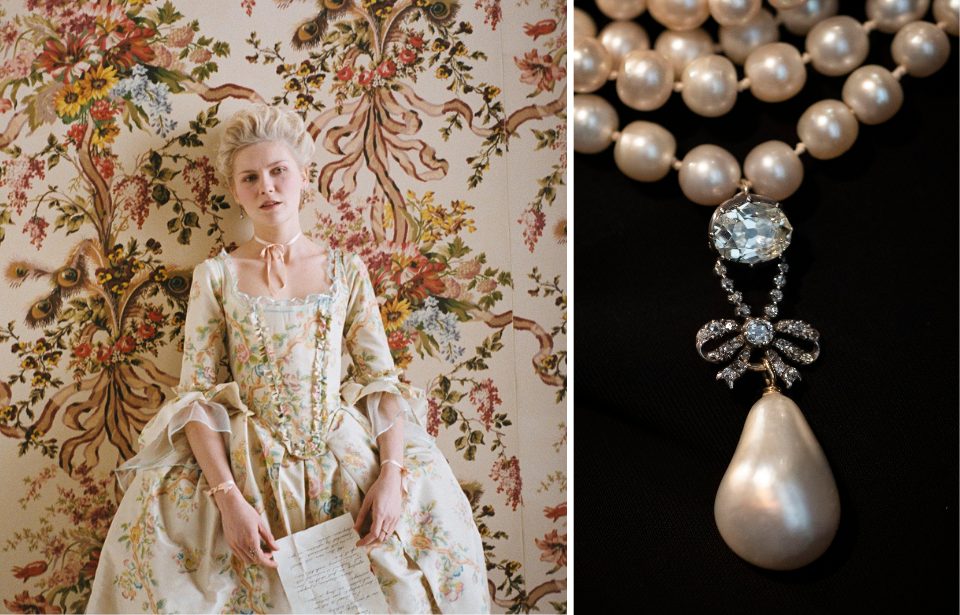Catfishing is a common phenomenon in 2021. The rise of social media has made it much easier for people to pose behind a screen and pretend to be someone else. Obviously, there is a major correlation between catfishing and social media, but people have been deceived in a similar fashion throughout history. In fact, one of the first known cases of catfishing involved none other than Marie Antoinette. Here, we break down an elaborate scam over a diamond necklace that Marie Antoinette found herself involved in, and which led to her eventual execution.
Introducing all the characters

In 1771, Cardinal de Rohan, Grand Almoner of France, was sent on a diplomatic mission to Austria, which was the homeland of Marie Antoinette. As a French ambassador in Austria, Rohan and Marie Antoinette’s mother, Empress Maria Theresa, often found themselves butting heads.
In 1774, Marie Antoinette became queen of France. In this year, Cardinal de Rohan returned from Vienna and found that he had fallen out of favor with Marie Antoinette. Marie Antoinette listened to the advice given to her by her mother and excluded Cardinal de Rohan from her inner circle. Because the Cardinal was no longer in good standing with the Queen, he could not achieve any of his political ambitions (including becoming Prime Minister), so he was anxious to get himself back into the Queen’s good graces.
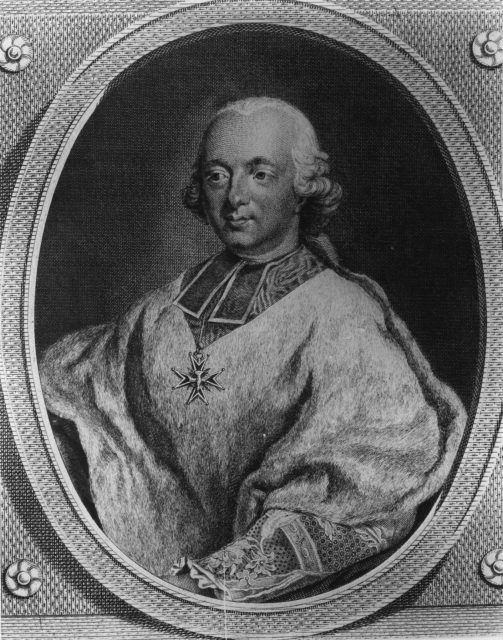
In 1783, Cardinal de Rohan became acquainted with a woman named Comtesse de La Motte (also known as Jeanne de Valois-Saint-Rémy). The Comtesse told the Cardinal that she was a descendant of the former French royal family (the Valois family) and that she was a good friend of Marie Antoinette.
The Comtesse de La Motte did have some claim to a royal bloodline. Her father, Jacques de Valois, Baron de Saint-Rémy, was a descendant of King Henry II of France. However, though Jacques inherited an estate from his father in northeastern France, he did not get any money. The Comtesse de La Motte had once tried to win the favor of Marie Antoinette, but the Queen had refused to meet the Comtesse after hearing about her shady background.
Nevertheless, the Comtesse de La Motte saw an opportunity to manipulate Cardinal de Rohan, who so desperately wanted to get back into the good graces of the Queen. The two became lovers in 1783.
The affair of the diamond necklace
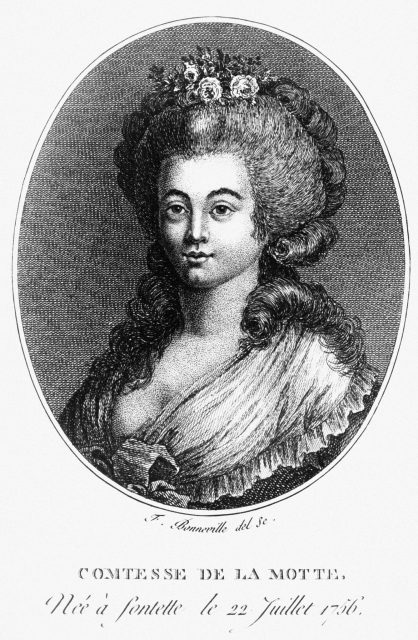
The Cardinal began “corresponding” with Queen Marie Antoinette. La Motte encouraged Rohan to write letters to the Queen, which she told him she was passing on to Marie Antoinette on the Cardinal’s behalf. However, in reality, La Motte was having her other lover, a man named Rétaux de Villete, create the replies from Marie Antoinette.
While this exchange of letters was happening, the Comtesse de La Motte learned of a diamond necklace that the Crown jewelers, Böehmer and Bassenge, had been trying to sell for several years. This diamond necklace contained nearly 650 diamonds and weighed almost 2,800 carats. This necklace had first been presented to King Louis XVI in 1782, but Marie Antoinette had turned it down. In 1784, the price of the necklace was reduced to 1.6 million Livres, or about $15 million US dollars today.
In the letters, Comtesse de La Motte (posing as Marie Antoinette) hinted to Cardinal de Rohan that she desperately wanted to purchase this diamond necklace. In fact, “Marie Antoinette” told Rohan that she was prepared to make a formal reconciliation at court if he (Rohan) would facilitate its purchase by negotiating with the jewelers.
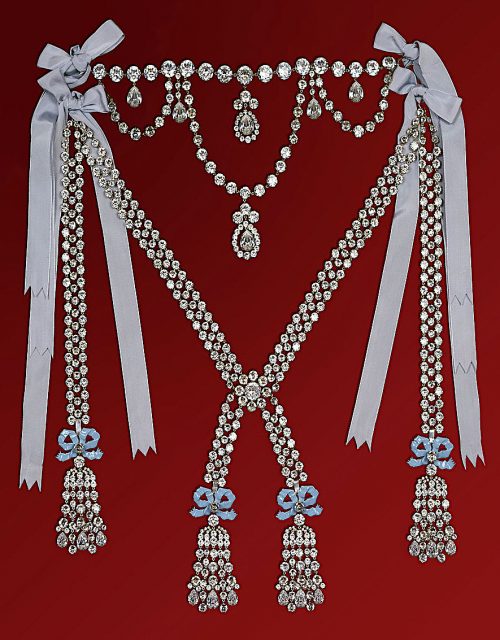
Comtesse de La Motte arranged for a late-night liaison in the garden of the Palace of Versailles, where the Cardinal was to meet “Marie Antoinette.” Instead, Comtesse de La Motte sent a prostitute named Nicole le Guay d’Olivia, who slightly resembled Marie Antoinette, to meet with the Cardinal. However, this meeting completely convinced Cardinal de Rohan that the Comtesse de La Motte was truly friends with Marie Antoinette, and he agreed to contact the jewelers and pay for the necklace in installments.
On February 1, 1785, the jewelers handed the diamond necklace over to Cardinal de Rohan, who promptly presented it to Comtesse de La Motte, who said she was going to give it to Marie Antoinette. Almost immediately, Comtesse de La Motte and her husband began selling off individual diamonds in London to make fast cash.
On July 12, 1785, the jewelers sent a letter to (the real) Marie Antoinette, in which they mentioned the necklace. However, because the real Marie Antoinette had not been involved in the ordeal, she destroyed the letter. A month later, the jewelers (who still had not received any payment for the diamond necklace), sent another letter – this time to Marie Antoinette’s lady in waiting, Jeanne Louise Henriette Campan. Madame Campan reported this news to Marie Antoinette, who demanded a full explanation.
On August 15, Cardinal de Rohan was arrested in the Hall of Mirrors. Comtesse de La Motte was also arrested, along with her other lover Rétaux de Villette. The prostitute Nicole d’Olivia was also implicated.
The aftermath of the scandal
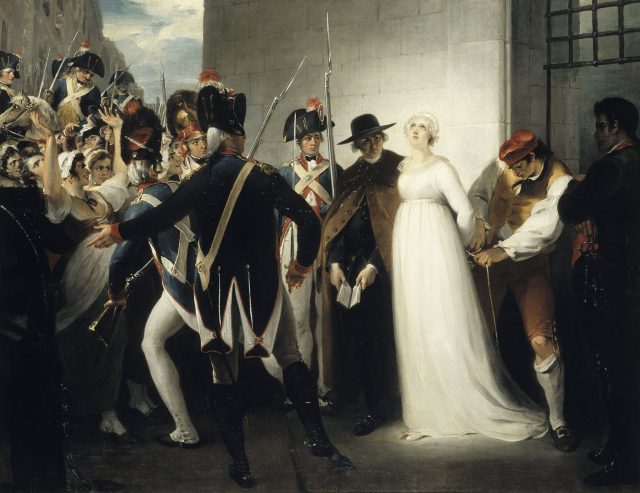
In May 1786, Cardinal de Rohan was declared innocent by the Parlement de Paris, and exiled to his own property in southern France. Comtesse de La Motte, who was at the heart of this plan, was found guilty and sentenced to be whipped, branded, and imprisoned for life. Despite being branded with a hot iron with a “V” for Voleuse (thief), Comtesse de La Motte would later escape prison and make her way to London. Once in London, she published her memoirs, in which she blamed Marie Antoinette for the entire ordeal.
More from us: Curse of the Hope Diamond, Marie Antoinette’s Dazzling and Dreaded Jewel
Although Marie Antoinette and Louis XVI were completely unaware that they had been scammed, the decision to publicly prosecute the people involved had a negative impact on their reputation. The French people believed Marie Antoinette manipulated Comtesse de La Motte to seek revenge on her real enemy, Cardinal de Rohan. Marie Antoinette’s reputation would never recover, and only a few years later she would be beheaded in the French Revolution.
